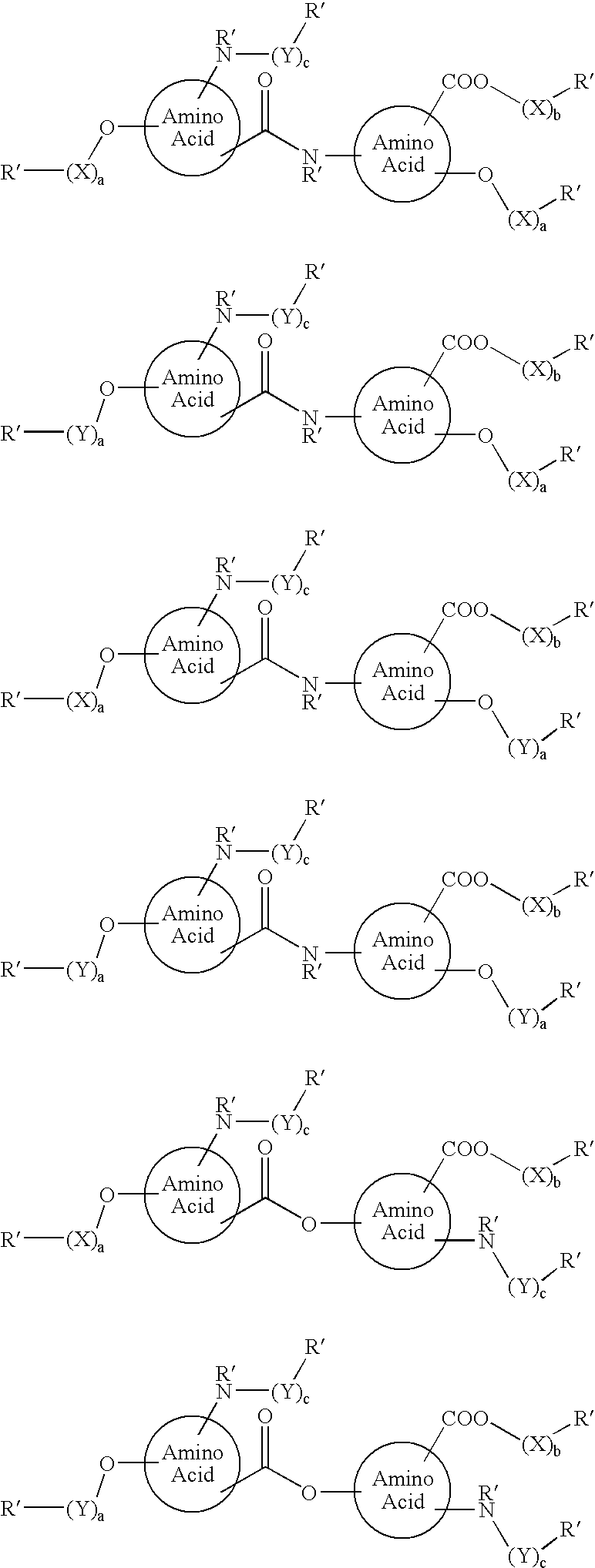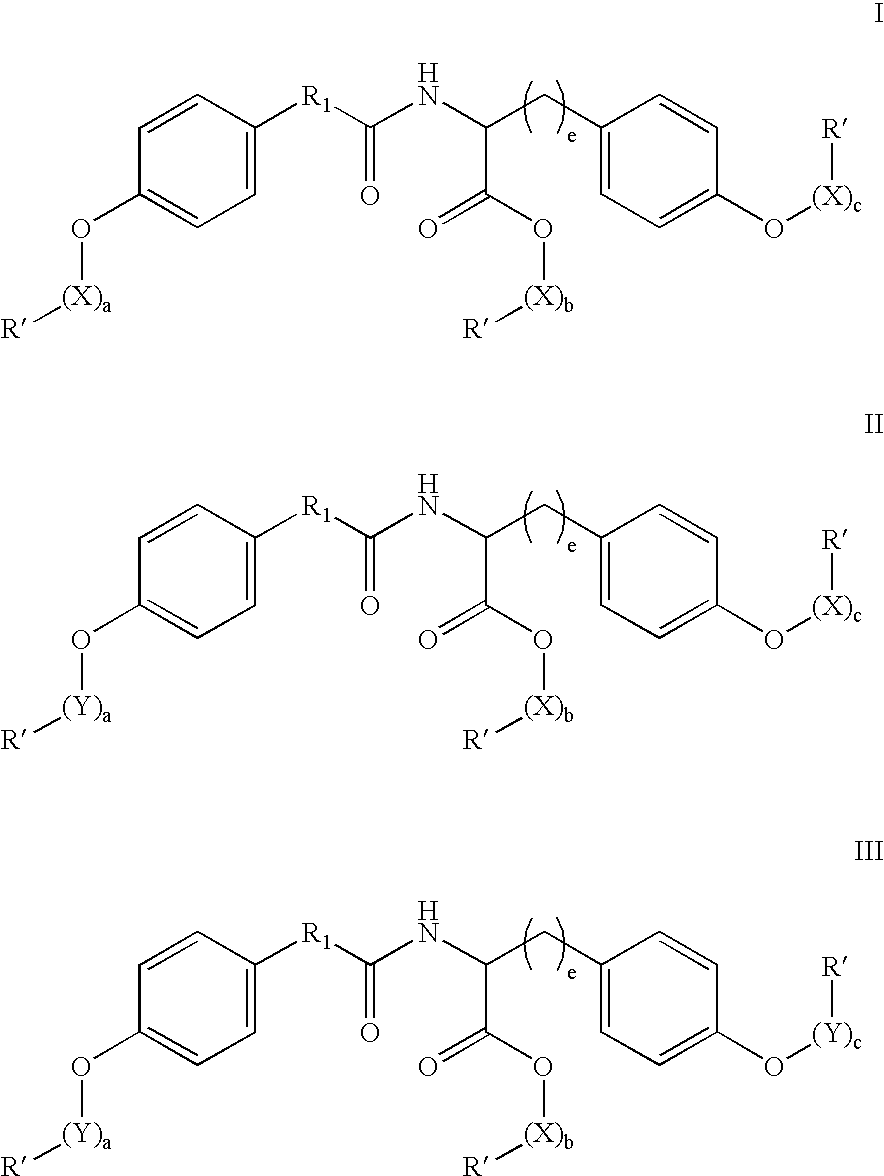Functionalized diphenolics and absorbable polymers therefrom
a diphenolic, functional technology, applied in the field of functionalized diphenolics, can solve the problems of loss of mechanical strength, reduced molecular weight of polymers made from them, and limited application of monomers,
- Summary
- Abstract
- Description
- Claims
- Application Information
AI Technical Summary
Benefits of technology
Problems solved by technology
Method used
Image
Examples
example 1
2-Amino-3-(4-hydroxy-phenyl)-propionic acid methyl ester
[0194]
[0195] To a mixture of L-tyrosine (50 grams, 275.95 mmol) in methanol (875 mL) at 0° C. was bubbled anhydrous hydrochloric acid for 5 hours. The mixture was stirred at room temperature for 17 hours. Methanol was distilled under vacuum below 40° C. Ice cold water (100 mL) was added and the pH adjusted to 8 with aqueous ammonia. The crude 1 was filtered, dried and recrystallised from ethylacetate to give pure 1 (40 grams, 74.3%) as cream color shining powder. M.p: 134.5-135.5° C. (lit 135-139° C.).
example 2
3-(4-Hydroxy-phenyl)-2-phenethyloxycarbonylamino-propionic acid methyl ester
[0196]
[0197] To a mixture of 2-amino-3-(4-hydroxy-phenyl)-propionic acid methyl ester 1 (5 grams, 25.61 mmol) and sodium bicarbonate (2.3 grams, 27.37 mmol) in ethylacetate (100 mL) at 0° C. was added benzyloxy acetyl chloride (5.2 grams, 28.18 mmol) drop wise. The mixture was stirred at room temperature for 5 hours. The solids were filtered off, and the ethyl acetate layer washed with 5% sodium bicarbonate (2×10 mL), water (2×10 mL), dried over sodium sulphate, distilled, and purified by column chromatography on silica gel using benzene as eluant to give pure 2 (5 grams, 62.8%) as a white powder. M.p: 68-70° C. 1H NMR (CDCl3) δ 3.14(m, 2H, CH2), 3.74(s, 3H, Ester), 3.94(s, 2H, CH2), 4.48(d, 2H, CH2), 4.90(q, 1H, CH), 6.64(d, 2H, Ar), 6.92(d, 2H, Ar), 7.08(d, 1H, NH), 7.30(m, 5H, Ar).
example 3
2-(2-Hydroxy-acetylamino)-3-(4-hydroxy-phenyl)-propionic acid methyl ester
[0198]
[0199] 3-(4-Hydroxy-phenyl)-2-phenethyloxycarbonylamino-propionic acid methyl ester 2 (5 grams, 14.57 mmol) was dissolved in methanol (25 mL) in a pressure vessel. Pd / C (5%, 3 grams) was added, and the mixture stirred under an atmosphere of hydrogen (3 Kg) for 24 hours. The catalyst was removed by filtration, and the methanol distilled off. Crude 3 was purified by column chromatography on silica gel using chloroform as eluant to give pure 3 (2.5 grams, 67.9%) as a light yellow syrup, which crystallized very slowly to a white powder and further recrystallised in a mixture of ethyl acetate:hexane (1:6) to give pure 3 (2 grams) as a white powder. M.p: 57-58° C. 1H NMR (CDCl3+DMSO-d6) δ 3.00(d, 2H, CH2), 3.70(s, 3H, Ester), 3.92(d, 2H, CH2OH), 4.72(q, 1H, CH), 5.50(t, 1H, OH), 6.72(d, 2H, Ar), 6.92(d, 2H, Ar), 7.40(d, 1H, NH), 8.96(s, 1H, OH).
PUM
| Property | Measurement | Unit |
|---|---|---|
| weight-average molecular weights | aaaaa | aaaaa |
| weight-average molecular weights | aaaaa | aaaaa |
| temperature | aaaaa | aaaaa |
Abstract
Description
Claims
Application Information
 Login to View More
Login to View More - R&D
- Intellectual Property
- Life Sciences
- Materials
- Tech Scout
- Unparalleled Data Quality
- Higher Quality Content
- 60% Fewer Hallucinations
Browse by: Latest US Patents, China's latest patents, Technical Efficacy Thesaurus, Application Domain, Technology Topic, Popular Technical Reports.
© 2025 PatSnap. All rights reserved.Legal|Privacy policy|Modern Slavery Act Transparency Statement|Sitemap|About US| Contact US: help@patsnap.com



